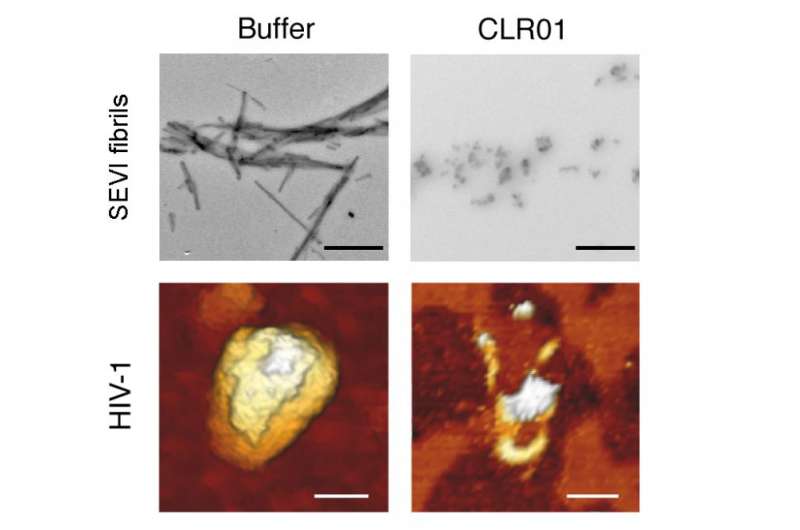Targeting HIV in semen to shut down AIDS

There may be two new ways to fight AIDS—using a heat shock protein or a small molecule - to attack fibrils in semen associated with the human immunodeficiency virus (HIV) during the initial phases of infection, according to new research from the Perelman School of Medicine at the University of Pennsylvania. HIV is most commonly transmitted between individuals in semen, the male reproductive fluid, which contains deposits of protein fragments called amyloid fibrils. These fibrils can increase the transmission of HIV by helping the virus attach to the membrane surrounding human cells. The scientists surmise that therapies that reduce the levels of amyloid fibrils in semen might be able to reduce the transmission of HIV.
Senior author James Shorter, PhD, an associate professor of Biochemistry and Biophysics, notes the first paper, published in Chemistry & Biology earlier this month, describes how the investigators repurposed a yeast heat shock protein called Hsp104 to attack amyloid fibrils. First, Hsp104 and an enhanced engineered variant directly remodeled fibrils into non-amyloid forms. They also made inactive Hsp104 scaffolds that reorganized fibrils into larger, innocuous assemblies. And finally, they modified Hsp104 to interact with a chambered enzyme to irreversibly degrade fibrils from semen.
"Each strategy diminished the ability of amyloid to promote HIV infection, so this approach has potential as a therapeutic," Shorter said. The work was a team effort driven by lead author Laura Castellano, PhD, who obtained her doctoral degree in the Shorter lab, and coauthor Drew Weissman, MD, PhD, a professor of Medicine in the division of Infectious Diseases.
Another paper, published today in the journal eLife, by Shorter, Castellano and their collaborators at Ulm University Medical Center, Germany, including Jan Münch and Edina Lump, describes a second approach - a small molecule that also disrupts amyloids in semen that promote HIV infection. However, this molecule, called CLR01, also attacks the virus itself.
Tweezers-shaped CLR01 can both disrupt fibril formation and disassemble fibrils that have already formed. CLR01 prevents HIV particles from interacting with fibrils by disrupting the membranes that surround the virus particles and can displace the virus particles that have already bound to the fibrils. In the presence of CLR01, human cells exposed to semen that contained HIV were at least 100-fold less likely to become infected with the virus.
CLR01 was also effective at directly disrupting other enveloped viruses, including hepatitis C virus, human cytomegalovirus, and herpes simplex virus, but was ineffective against the non-enveloped human adenovirus type 5. CLR01 may also be effective against many other enveloped viruses including flu and Ebola.
Amyloid fibrils formed by different proteins in the brain are associated with neurodegenerative disorders, such as Parkinson's disease, and CLR01 could also be useful for these disorders, say the authors. The Breakthrough Treatment for Degenerative Diseases is a collaborative, international team pursuing CLR01 for these disorders.
"CLR01 has considerable potential to be used as a therapy for reducing the transmission of HIV and other sexually transmitted viral diseases," said Shorter. "Remarkably, CLR01 does not affect cell membranes, which suggests it could be safely incorporated into a vaginal or anal gel to prevent HIV infection - without the risk of side effects."
The next step could be to assess safety and efficacy in non-human primates. "We think that CLR01 could be more effective than other microbicides that are in development because of its dual action, its safety in terms of side effects and its potential broad application," Shorter said.
More information: The paper 'A molecular tweezer antagonizes seminal amyloids and HIV infection' can be freely accessed online at dx.doi.org/10.7554/eLife.05397


















